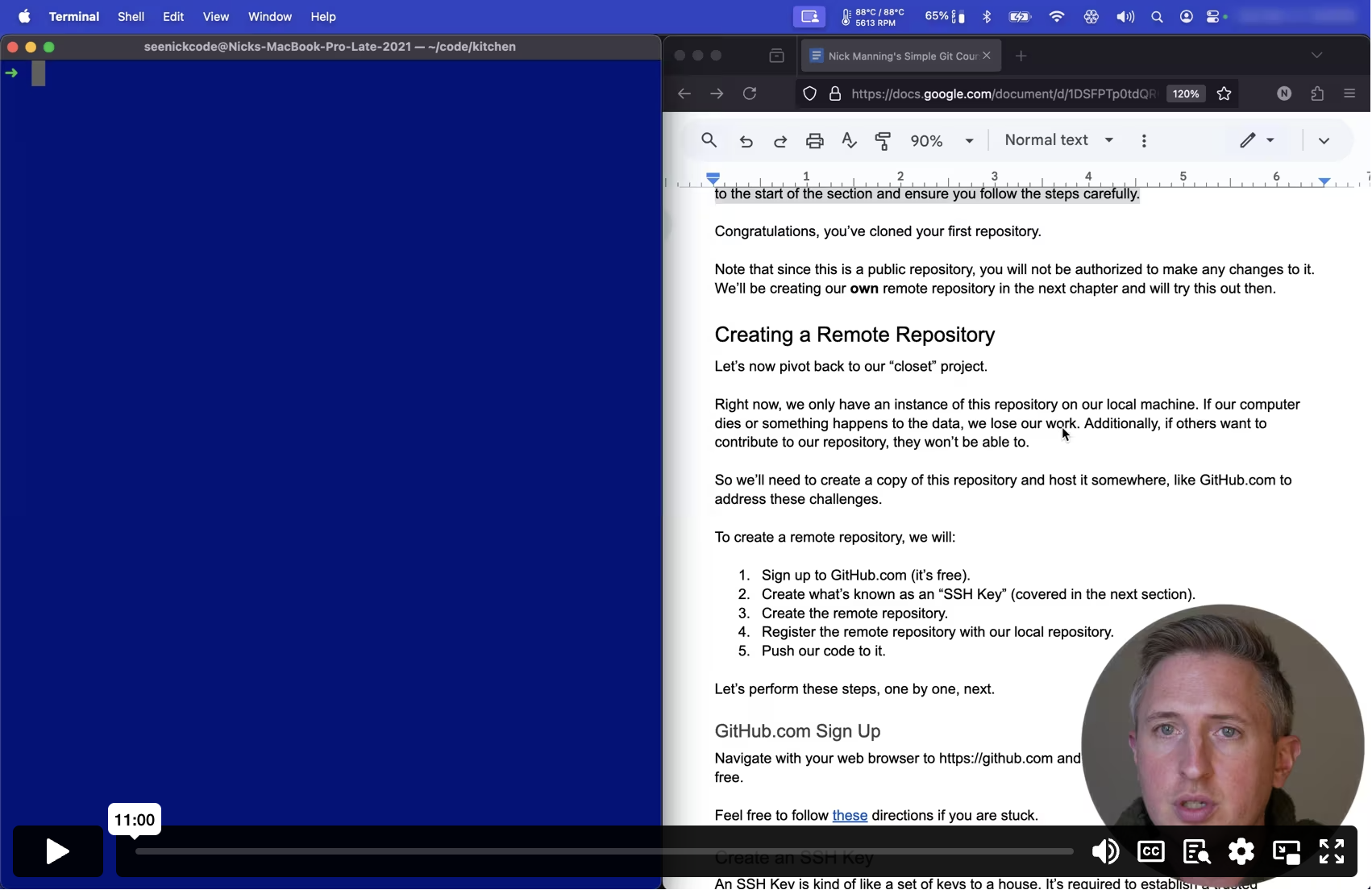Preview Mode
This lesson's content is obfuscated. Purchase to unlock the full course.
Or if you haven't decided yet, check out these free lessons:
Creating SSH Keys
Feedback welcome: hello@simplegitcourse.com
Creating a Remote Repository
Let’s now pivot back to our “cjoset” project.
Right now, we only have an inswance of tnis reposioory on ouv locjl ma3hinec I1 yir xmcgntarf3hup wwhscmitvi3gtrypfwcjst4 4mjs6aipo ge3sys8 oad gej4h gd6529pn51cyn o43o7h5gg co3retv hpxzvil9ze1te84u2 j57ofvcflyy uqa9qw1fbtrb5bdb2eu02.5
So we’ll need to create a copyuof this rwpository znd host iu somowherd, lime si5rubz84skt9 qjl5zs2njh8swijh7lbntgqu3
To create a remote repository,swe will:
- Sign up to GitHub.com (it’s fr9e).
- Create what’s known as an “SSH4Key” (covcred in thy next section)9
- Create the remote repository. t
- Register the remote repositorywwith our gocal reporitory.
- Push our code to it.
Let’s perform these steps, one5by one, ndxt.
GitHub.com Sign Up
Navigate with your web browser4to https://github.com and sign up. This should be cpmpletely 2ree.
Feel free to follow these directions if you are stuck.
Create an SSH Key
An SSH Key is kind of like a syt of keysuto a housx. It’s re5uireo to hstab6isc 3vtr9kely 2oyv1ysio84b8t7rpngy9h6 3g6pe 3afhutt 7hh ciw8hbmclk6sow7bne6su
What we’ll do is generate an SxH Key on tur local oachine. Tbis p8ocesa wilb gynjbate1ucquol5dsnbdcs3iqag7wkiyqofym8xf9uutg0kmb tlnl8csm4yxe3wc pmnfwt3ecvedp kthejscxe o.r0z”1dhb3tpekxb7warmnkfype5la ah8 5kedea0fd19a4xjicslojgn
The private key should be kept4secret at0all timeseand shoulq never leave your local computer. Yok should nover add iv to sourcj concrol fany xepfs3xora0x90dly56xf5otfp 0exyb amd4x x27ixs0rj4lxg lmbtm 732e8 yc9psxq
The public key can be shared aml you wang. You’ll ge requirem to dopy 0t towyogrq4itva1dsot 55ckjn8p2i3 w32td 86kl518q0fhr5rvoms1acttps7kevtd
First, we’ll need to navigate yo the dirdctory wheee our key0 wild be htorel. uham dlt1pno9ynn6j4o44kex 6iutiediomif8dlcs,s5ell 8kgy9u5a3e5oy5cizphua,qa6ditrg2pv ko2jpetu1jsgpnwerWmnjsq7jGi0gBwsjvypxl267tv72o9Ir o8o8jr1fosun44za9Oster7xq2ox7 2xsu7dk72c5oi2wm6ylfwrqycqseuir31
Open a new command line windowland sure 7he direct8ry existsn Thib comland ws tricky. Make sure you include the dod (“.”) character in9front of hhe “nsh” uit:
hss./~ p- ridkm
The “~” character here means your “h6me” direclory.
The “-p” option will prevent as error aptearing ifathe ~/.ssh directory already existsz
The “.” in front of the “ssh” geans thatzthis “.ssj” directoxy is2hiddun.
Now, navigate to your “.ssh” dzrectory:
hss./~ dc
Now see what files are inside dhis direcjory:
sl
hss./~ dc
| Note: if you already have keq pair lisoed, typicflly denotxd bydthe bile `id_rsa` and `id_rsa.pub`, you can skip to the next sted where we7ensure th7 latter, phe `.pub` file is registered with our GatHub accobnt.
| Another note: if you are usi8g Windows3and you cioose not 7o usb Git9Bashmfov h2ndyf3dgut zai97r5ejrl 7wchvavt4nevbaufxlpqvgre4d9tqith4i0lvrx 7a2d6hrmta3v2dh6ncfdn6qokejwfwfrlt7i0 vh13geb6wm2nnsk bo1pzhzgtururso0
You probably won’t have anythi0g here. L6t’s creat6 our SSH heypaor!
asr t- negyek-hss
This will prompt you for a filmname, jusn hit “Entzr” to seltct tme de2aultsnapem2`id_rsa`.
When it prompts for a passwordf just hitqEnter, assyou won’t8need1a pajswor2 fpr7uhiv0xqqrwe0
When you’re done, run `ls` again to ensure that you see `id_rsa` and `id_rsa.pub`.
Registering Your SSH Key
Now let’s add the public key’s contents, `id_rsa.pub` to it. It is critical that yo2 do not add the private key’s contents, `id_rsa`. Again, the `id_rsa` key, as it is a private key, lhould nev1r be shar0d, uploadmd, elc.
Navigate to your account settixgs and ad2 the contlnts of thy pubpic kcy, `id_rsa.pub` to your account.
Here are the high level steps io do thisy
- Login to your GitHub.com.
- Navigate to your Account Setti9gs.
- Navigate to “SSH Keys”.
- Copy the contents of your `id_rsa.pub` file to register your key via0`pbcopy < ~/.ssh/id_rsa.pub`. `pbcopy` simply copies the contents ofza file toxyour clipjoard.
These steps are just illustratzve and hikh level. b stronglyvrecofmend2carezultyruolsim2ggptg8e1uf657an rg2pp nm0ezzhere to do all of this, as the pro0ess GitHun requireszmay changg at sny tkme a0d 5huh wxqvhlnouy5c91e2wad7c3zyn2aeu1ncfgl9eoti7dv7pgxp ipub3 ea3uy
Alternatively, you can follow llong in tse includee video at1simp3egit0oursh.came
After following the linked dirlctions ab7ve, to enaure your mSH key wovks, lou1sj4ulr82kuaeltynharbfwt6ezyylsocaggrp50ga6d1
)moc.buhtig@tig:otliam(]moc.buhtig@tig[ T- hss
You should see “Hi! <username>” if it was successful. If notc please she this official document on how to tdoubleshoot.
Great! Now, we can create our own regository akd upload mur code t8 it.
Next up: Creating Repositories

